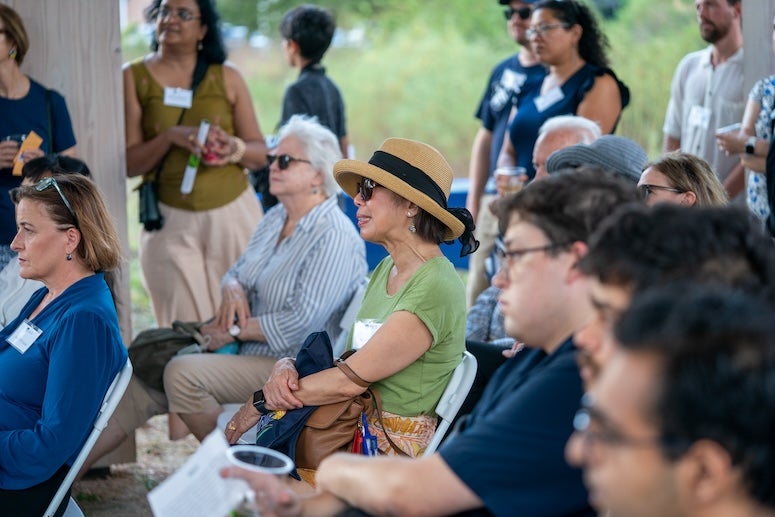More than 50 guests gathered at Rice University Nov. 8 to celebrate the 25th anniversary of the Lynn R. Lowrey Arboretum, a sanctuary of native Texas plants spanning the entire campus. Named after horticulturist and conservationist Lynn R. Lowrey, the arboretum has become a vital resource for education, research and conservation efforts since its founding in 1999. The milestone occasion honored the arboretum’s history and marked the launch of a multiyear restoration project to revitalize the Harris Gully Natural Area (HGNA), bringing parts of Rice’s landscape closer to their original ecological state.

With the HGNA project expected to be completed in 2026, Rice aims to restore this area that once held remnants of the historic Harris Bayou. The undertaking connects to the university’s 10-year strategic plan to become a global leader in teaching and research, including meeting objectives such as generating sustainable futures and building thriving urban communities. By enhancing natural spaces, Rice aspires to create a dynamic link between the campus environment and public health innovations, particularly through its proximity to the Texas Medical Center.
“The pathway through the Harris Gully to the Texas Medical Center reflects the connection between nature and well-being and ties into innovations in health, a key research driver,” Amy Dittmar, the Howard R. Hughes Provost and executive vice president for academic affairs, told the crowd.

During the celebration,Thomas Killian, dean of the Wiess School of Natural Sciences, highlighted the arboretum’s role in fostering environmental awareness. “At a time of existential climate challenges, it is essential that we are all environmentally literate and understand the importance of preserving the natural environment and creating sustainable futures,” Killian said. “Rice must lead this effort, and for 25 years, the arboretum has helped Rice to do that through projects that promote conservation and sustainability, campus beautification, public outreach and education and research.”
The HGNA restoration project will implement ecologically focused improvements, including soil enrichment through cover crops, the reintroduction of native prairie plants and the construction of a new pond to support wetland biodiversity.
Cassidy Johnson, interim director of the Lowrey Arboretum and lecturer of biosciences, emphasized that these enhancements will support local wildlife and provide critical ecosystem services to the Rice community.
“Rice is very unique in the fact that its entire campus is an arboretum,” Johnson said. “We have this arboretum on campus that is right outside the door of all of our classrooms to go and explore. There’s so much that we are still learning from nature.”

university architect, and Cassidy Johnson, interim director of the Lowrey Arboretum and lecturer of biosciences. Photo by Brandon Martin/Rice University.
The HGNA, channelized and partially buried under concrete bunkers in the 1950s as the university expanded, was once home to many native species, including river otters, various insects and native plants. The goal now is to unearth and rejuvenate these habitats, allowing them to serve as both educational and ecological resources.
“You can walk over to those concrete bunkers and still hear it running underneath the ground, where it flows underneath Main Street, underneath the Texas Medical Center and into Braes Bayou,” Johnson said.
The Lowrey Arboretum and the HGNA embody Rice’s strategic objective to advance sustainability and foster thriving urban ecosystems. Over the years, students and faculty have recorded more than 250 species of birds on campus, around 300 species of plants, 700 species of insects, five species of amphibians and five species of reptiles. Johnson’s conservation biology lab continues to engage students in gathering biodiversity data that reveal the campus’s ecological richness, and Scott Egan, associate professor of biosciences, and his research team have discovered new species such as the recently identified wasp called Chrysonotomyia susbelli.

The 25th anniversary also celebrates Rice’s designation as an accredited arboretum, a status that signifies its commitment to high standards in conservation, education and public engagement. With a growing collection of over 4,600 trees that includes 125 species, including oaks, elms and pines native to Texas and northeastern Mexico, the arboretum is both an academic and community asset.
“With the restoration the arboretum has planned at Harris Gully, Rice has the potential to have three ancient ecosystems stitched back,” Johnson said. “There are not a lot of college campuses where you can go to school, take a walk down a sidewalk and encounter three different ecosystems in one place. We have so much biodiversity, and we’re capitalizing on it. I hope our community gets excited about that.”

